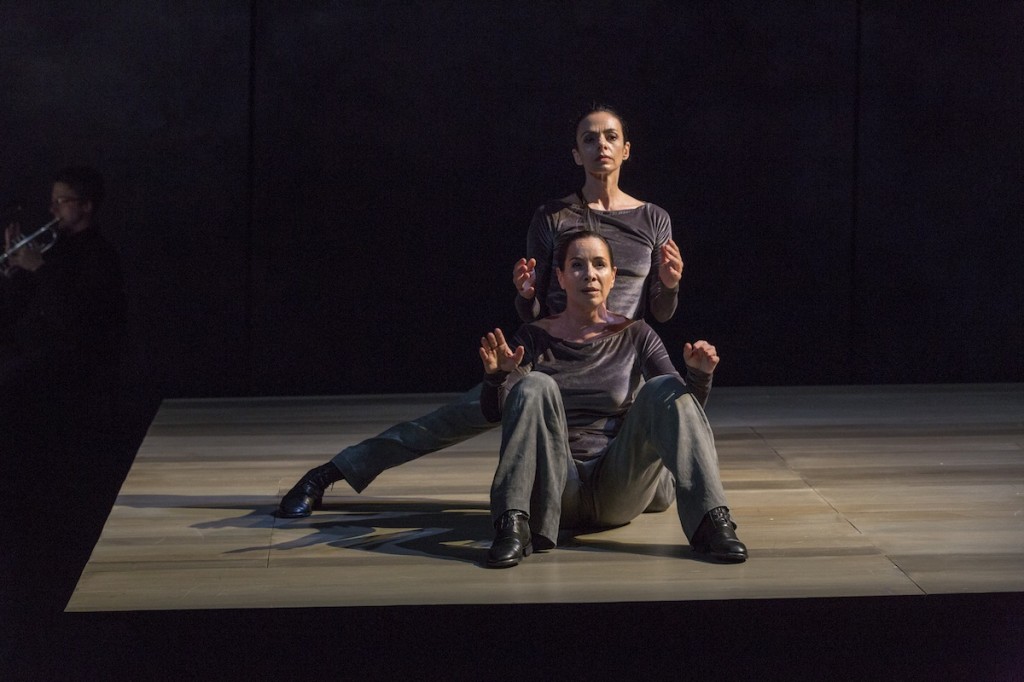Philharmonic Biennial off to mixed start with Hosokawa premiere

Mezzo-soprano Fredrika Brillembourg (front) and dancer Alessandra Ferri in Gotham Chamber Opera’s U.S. premiere of Toshio Hosokawa’s “The Raven.” Photo Richard Termine
The New York Philharmonic’s ambitious inaugural Biennial festival of new and contemporary music opened Wednesday night at the Gerald W. Lynch Theater, with the final production of Gotham Chamber Opera’s equally ambitious current season: the American premiere of Toshio Hosokawa’s The Raven. The title is a dead giveaway that Hosokawa’s composition is based on Edgar Allan Poe’s poem, using the same text as material for a single singer, mezzo-soprano Fredrika Brillembourg.
The Raven is not really an opera and not quite a monodrama. The form is more of a musical recitation, emphasizing the rhetoric of Poe’s verse without turning it into drama. As attractive as much of the piece is, its singular quality of form and compact duration opened up structural problems that Gotham Chamber Opera did not entirely solve.
Both poem and composition are about internal states—depression, hallucination, madness even. The score supports this with evocative stabs and jabbering of the instruments—similar to Salvatore Sciarrino—and here conducted by Neal Goren (with particularly expressive flute playing by Sato Moughalian). The vocal lines are set within a controlled and relatively confined range of pitch and dynamics, opening up on a few piercing instances of “nevermore!”
The singers’ phrases are both short and long as they circle around pedal tones in a modal manner. There’s not much harmonic variety and no dramatically transformative modulations from one key to another. Everything focuses on the mezzo, and, in this staging, dancer Alessandra Ferri.
Director and choreographer Luca Veggetti uses the dancer as an extension of the singers’ pysche, drifting away and back, shadowing mood and thought, even intertwining with Brillembourg for several acrobatic poses that the singer held with ease in both her body and voice. The effect was enhanced by Clifton Taylor’s simple and purposeful lighting design.
Brillembourg was strong throughout, the dark color of her voice is ideal for the music, and her phrasing was elegantly musical and expressive.
She was less successful in the strange and thankless task that Hosokawa demands, which is not singing but rather reciting whole lines of verse in a manner that sits uncomfortably between straight reading and dramatic intonation. There is slight emphasis on multiple pitches in these stretches—too much for reading and not enough for music. And while the overall score barely suggests a rhythmic profile, these lines are set to strict rhythm, and Hosokawa’s scanning is in awkward opposition to the natural syllabic rhythms and accents of Poe’s words.
The Raven begins with recitation from the singer, and there is a welcome contrast between speaking and singing, but the back and forth sounds arbitrary without a discernible musical or dramatic purpose. One searches for a dialogue that never really arrives, and the technique undercuts the overall strength of the music.
Doing the same to the entire evening was the opening piece, André Caplet’s decadent, symbolist and truly third-rate Conte fantastique: Le Masque de la Mort rouge. There seemed to be two reasons this work for harp and string quartet was on the program: because of the superficial connection to Poe and to pad the length of the performance to around seventy minutes.
The music is full of obvious narrative and romantic gestures and, worse, is completely boring, a bad way to set the mood and a confusing way to cogently present the purpose of the overall event. The ensemble offered acceptable playing from violinists Christopher Lee and Austin Hartman, violist Nardo Poy, cellist Serafim Smigelsky and harpist Sivan Magen.
The Raven is not long enough to fill a whole evening, but the quality of the music and the focus on the woman’s voice as narrator screams for some obvious but far more meaningful companionship: Erwartung, La voix humaine, or even Sciarrino’s Infinito nero. Perhaps Caplet’s piece was thought to be a safe way to open the concert and the festival, an appetizer of melodies and triadic harmonies before anything weird happened.
The Raven runs through May 31. The Biennial runs through June 7. gothamchamberopera.org; nyphil.org.






